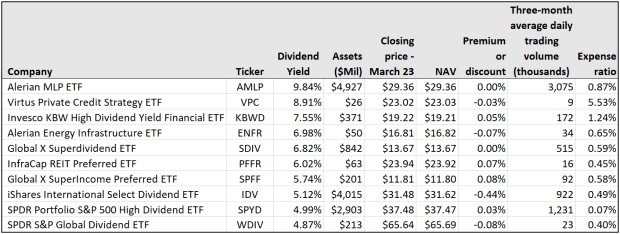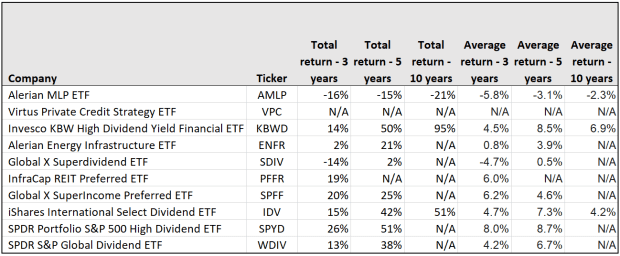10 highest-yielding dividend-stock ETFs for a low-rate world
Federal Reserve Chairman Jerome Powell this week said the central bank will “provide the economy the support that it needs for as long as it takes.”
That means low interest rates are likely to persist, keeping a lid on income-producing investments.
A way to get ahead is with dividend stocks and the exchange traded funds that hold them. Below is a list of U.S. ETFs with the highest dividend yields — they range from 4.9% to 9.8%.
Mark Grant, the chief global strategist for fixed income at B. Riley Financial, wrote in his “Out of the Box” email March 22 that, with inflation at 1.68% last month, “you have to beat that rate to get any kind of ‘real return,’ or you are just playing mahjong” with inflation and the Federal Reserve.
With bond yields prohibitively low, he favors closed-end funds and exchange traded funds to meet that income objective. He warned that investors must do their homework to select the right ones.
ETFs are simpler to analyze than closed-end funds, especially ETFs with diversified portfolios.
Focusing on income, not growth
There’s a difference between investing for growth and investing for income. The objective of an income portfolio is not to beat the total return of a growth index. It is for income and capital preservation.
The stock market crash in March 2020 serves as an example of holding quality stocks for the long term. Regardless of how long recoveries take, if you are holding shares of companies that generate sufficient cash flow to cover their dividends, you can make money while riding out the volatility.
Dow Inc. DOW,
It’s obvious that the right thing for shareholders of Dow was to ride out the storm, but many investors didn’t have the stomach for it. Taking this idea further, at the close on that dark day of March 23, 2020, the yield on Dow’s shares had risen to 10.5%. The market had given patient investors an opportunity to lock in a very high yield.
All of this holds true for dividend stock ETFs, especially ones with high yields.
Highest-yielding dividend-stock ETFs
A query of FactSet data yielded a list of 66 U.S. ETFs that “weight stocks by dividends and/or seek high dividend yields.”
An advantage of ETFs is that they are easy to trade. You can buy or sell at any time when the stock market is open. Open-ended mutual funds allow you to sell your shares back to the fund company only once a day at the market close.
An open-ended mutual fund’s share price is its net asset value (NAV), which is the sum of the market values of its assets divided by the number of shares. It’s a fund’s book value.
ETFs have NAVs too, but also their own share prices which diverge from the NAV. Grant wrote that when analyzing closed-end funds and ETFs, he says “no thank you” if the share price is at a premium to the NAV. But while some closed-end funds can trade at high premiums to NAV, most of the dividend-stock ETFs listed here trade for small premiums or discounts.
Here are the 10 U.S. dividend-stock ETFs with the highest dividend yields as of the close March 23:

You can see that the premiums to NAV, if any, are small.
These ETFs have varied approaches, and you should go to the managers’ websites to read about the objectives and management styles of any you consider. Some are narrowly focused, which can increase risk.
The table includes three-month average daily trading volume. The larger your holdings, the more important liquidity becomes when you are trying to buy or sell at the best price on a given day. The second-highest yielding ETF on the list, Virtus Private Credit Strategy ETF VPC,
Regardless of liquidity, use limit orders for your trades. They don’t cost extra and can save you from temporary price distortions.
That Virtus ETF’s annual expense ratio might seem alarmingly high at 5.53%. However, this is another area where investors need to take a second look. The fund invests in business development companies and closed-end funds, which are required to include their own interest expense (since they are leveraged) as part of their management fees. The annual management fee for the Virtus Private Credit Strategy ETF is 0.75%, and the rest of that 5.53% expense ratio represents the management fees of the BDCs and closed-end funds it holds.
The Invesco KBW High Dividend Yield Financial ETF KBWD,
However, FactSet has this to say: “The fund’s eye-popping fee is a regulatory illusion. It’s required to report the operating expenses of its private equity holdings as part of its expense ratio. Real-world holding costs have been consistently in line with KBWD’s very reasonable management fee” of 0.35%. The ETF focuses on real-estate investment trusts, as well as private-equity funds.
The largest ETF on the list is the Alerian MLP ETF AMLP,
The listed ETF with the second-highest trading volume has been the SPDR Portfolio S&P 500 High Dividend ETF SPYD,
While it is important to emphasize, again, that income is the main objective here, total returns (with dividends reinvested) can make for useful comparisons of long-term performance.
Here are total returns and average annual returns for the group for three, five and 10 years.

The SPDR Portfolio S&P 500 High Dividend ETF has had the best returns for three and five years, while the Invesco KBW High Dividend Yield Financial ETF takes the prize among the three that have been around for 10 years.




